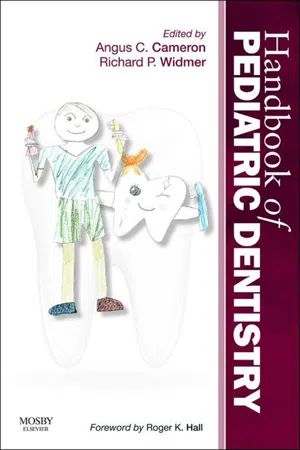
- 512 pages
- English
- ePUB (mobile friendly)
- Available on iOS & Android
Handbook of Pediatric Dentistry
About This Book
The new edition of this internationally recognised text offers comprehensive guidance on the successful management of the child in the dental setting.
Prepared by authors of international renown, the Handbook of Paediatric Dentistry presents a volume that takes the reader far beyond the technical skills that are needed to treat disorders of the childhood dentition and instead delivers a whole philosophy of integrative patient care.
Richly illustrated and in full colour throughout, the Handbook of Paediatric Dentistry is written in a friendly 'how to' manner and contains useful 'pull out' boxes to act as useful aide-mémoires. Exploring a variety of topics, the book includes discussion of child development, practical communication skills and advice on how to deal with behavioural problems. Clinical topics include the management of caries, fluoridation, restorative dentistry, pulp therapy, trauma management, oral medicine and pathology, dental anomalies, and the treatment of medically compromised children. Chapters also explore the use of orthodontics, the management of cleft lip and palate and speech, language and swallowing.
The Handbook of Paediatric Dentistry has become an essential chairside and bedside companion for all practitioners caring for children and is suitable for undergraduate dental students, general dental practitioners, specialist paediatric dentists, orthodontists and paediatricians.
-
- Established as the foremost available comprehensive handbook on paediatric dentistry
- Prepared in an 'easy-to-digest' fashion – which allows for quick reference and easy reading
- Contains over 550 full colour line artworks, photographs and tables together with 'Clinical Hints' boxes to act as useful aide-mémoires
- Sets out the essentials for managing conditions such as clefting disorders, haematological and endocrine disorders, congenital cardiac disease, disorders of metabolism, organ transplantation and cancer in children as well as more familiar presentations such as dental trauma, oral infections and caries
- Detailed appendices provide the reader with information that is often difficult to find and which may be overlooked
- Designed specifically to give all practitioners confidence when managing children
- Convenient handbook size ensures that the book can be easily referred to in the clinical setting
- Endorsed by the Australasian Academy of Paediatric Dentistry
- ~
- Improved layout and completely new colour illustrations
- Expanded section on sedation and use of nitrous oxide
- Includes details from the most recent international guidelines
- Cases expanded to show 20 year follow-up
- Includes the latest research findings in orthodontics
- Fully updated section on clefting problems
Frequently asked questions
The philosophy of paediatric dentistry

What is paediatric dentistry?
Patient assessment
History
Current complaints
Dental history
Medical history
Pregnancy history
Growth and development
Current medical treatment
Family and social history
Table of contents
- Cover image
- Title page
- Table of Contents
- Copyright
- Contributors
- Contributors to previous editions
- Foreword
- Preface
- Acknowledgements
- 1. The philosophy of paediatric dentistry
- 2. Child development, relationships and behaviour management
- 3. Pharmacological behaviour management
- 4. Dental caries
- 5. Fluoride and dental health
- 6. Restorative paediatric dentistry
- 7. Pulp therapy for primary and immature permanent teeth
- 8. Clinical and surgical techniques
- 9. Trauma management
- 10. Paediatric oral medicine, oral pathology and radiology
- 11. Dental anomalies
- 12. Medically compromised children
- 13. Children with special needs
- 14. Orthodontic diagnosis and treatment in the mixed dentition
- 15. Management of cleft lip and palate
- 16. Speech, language and swallowing
- Appendices
- Index